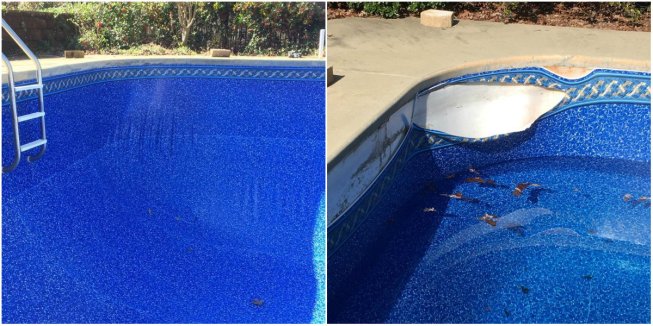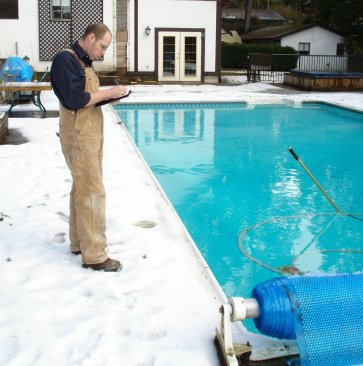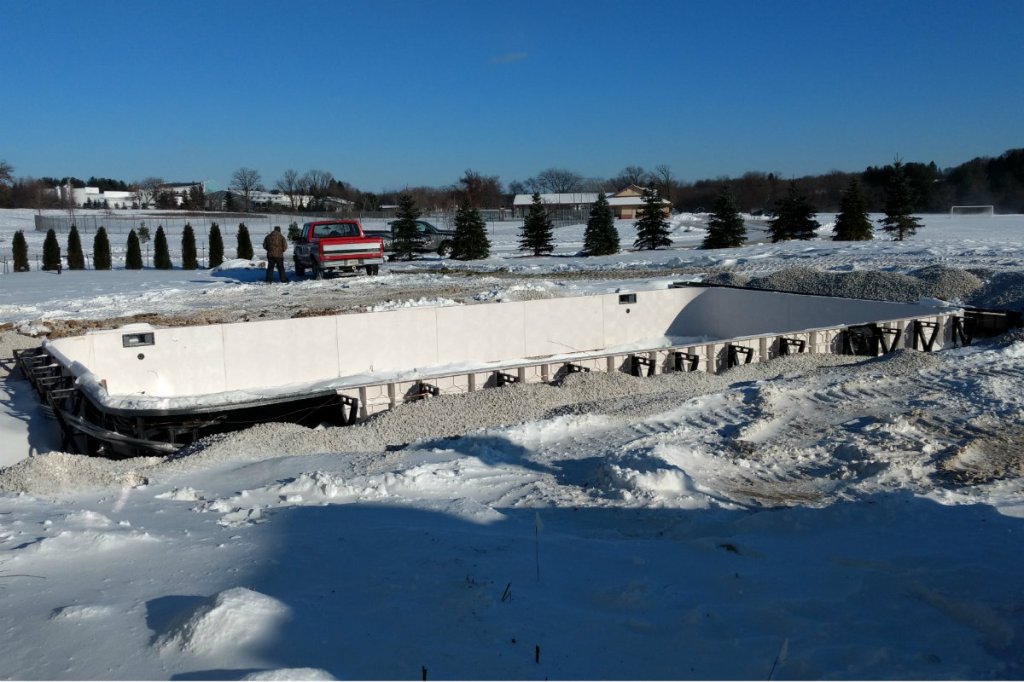When temperatures drop below, say, 60 degrees, a vinyl liner becomes stiff and uncooperative.
That’s why many manufacturers caution against installing in cold conditions.
But there are times when it’s unavoidable. For instance, a real estate transaction can spur a liner replacement in less than ideal circumstances. Eager to close a deal, a home seller won’t wait until spring, thank you very much. “If you don’t do it, I’ll find someone who will!” the agent will bark.
Plus, it’s not wise to leave a vessel empty without a liner. A rising water table can damage the structure, or vermiculite can crack when exposed to the elements. That liner should go in sooner rather than later.
And would you really turn down a job just because it’s a little frosty out? In the Northeast, some homeowners request pools built in winter so not a moment of those precious summer months are wasted during construction. Some builders do brisk business meeting these demands. Some even offer discounts. And why not? The cheapest time to buy a boat or a motorcycle is during the off-season when demand is low. For some dealers, the same applies to swimming pools.
Even during spring, weather can be wildly unpredictable in some regions. (We’re looking at you Northeast!)
Here, professionals share tips on how to master these chilly challenges.
A word of caution
Before agreeing to do a sub-60 degree installation, take a moment to understand the inherent risks involved.

(L) The liner looked fine the day it was installed. (R) The dealer was shocked to discover it had split overnight. That’s why some manufacturers caution against installing below 55 degrees.
Installers who have become competent working in frigid climes only did so through trial and error — emphasis on the word error. To make the material more manageable, one builder nearly melted the liner using a roofing torch. Another said he once used an outdoor-only propane heater under a makeshift tent — in retrospect, probably not the smartest idea.
There also is the possibility that, after stretching, pushing, tucking and tacking the stubborn liner snuggly into place, it will split down the middle overnight as temperatures drop and cold fill water rises.
The manufacturer might not honor the warranty, either.
Consider yourself warned.
Full of hot air
Mike Giovanone is aware of all the techniques pros have used in severe situations and considers many amateurish. As he sees it, there is only one way to warm a vinyl liner.
The CEO of Concord Pools in Latham, N.Y., recommends warming the underside of the liner using a torpedo-style portable heater. However, this only works on vinyl pools with concrete bottoms, since the material retains heat.
Begin by tacking the liner into place. “It’s going to be like tacking in cardboard,” Giovanone warns.
Next, hang a plumbing elbow over the coping, with about 3 feet of vertical pipe running between the liner and the structure. Attach a Sonotube to the mouth of the elbow, on the deck side. There should be about 6 feet running horizontally on the deck. Position the heater about 2 inches from the tube opening.
Fire up the heater. Now you’re channeling fan-forced air into the vessel, pressurizing the underside of the liner and creating radiant heat throughout.
Don’t worry about melting the liner. By the time it reaches the pool, the air will cool to about 110 degrees.
A tent or inflatable construction dome over the vessel will not be needed.
As the material relaxes and becomes more malleable, tuck the liner into its track. To ease the process, apply warm, soapy water along the top.
Next, place the vac hose down from the top of the skimmer, turn the vacuum on, immediately remove the Sonotube, and tack the rest of the liner in place.

Steve Goodale, of SwimmingPoolSteve.com, measures a liner for replacement in Ontario, Canada, where it is well below freezing for much of the winter.
Splash hot water in difficult corners or to smooth out wrinkles, “but sometimes this isn’t even needed,” Giovanone says.
This technique has proven effective in even the iciest conditions, Giovanone says, because it traps heat between the liner and the structure. “Now all of a sudden you’re dealing with 75 degree conditions, even though there are snow flurries,” he says.
Giovanone has another trick up his sleeve on higher-end installations. Concord offers radiant heat systems, in which hot liquid or antifreeze courses through a tubes embedded in the concrete floor and heats the pool from the bottom up.
If the crews know they’re installing a liner in the morning, they turn on the system to heat the floor overnight. The next morning, they’ll hang the liner and give it a moment to absorb the warmth. In the time it takes them to drink a cup of coffee, the material is as manageable as it would be on a fine summer day.
When warm water works
But say you have to replace a liner on a vessel with steel walls and a vermiculite bottom. What then?
Warm water is your only workaround.
It’s far from ideal, but it can make a stiff liner more cooperative under the right conditions.
To use this solution, connect a garden hose to the spigot at the hot-water hookup for the washing machine, or connect it directly to the home’s hot-water tank.
After hanging the liner, lightly spray water around the vessel. Use the nozzle to create a fine mist. Regulate at the spigot so there isn’t too much water pressure. Keep in mind that a gallon of water weighs 8 pounds, so be careful not to let too much water pool in the hopper. Weighted down, the liner will be difficult set in place.
Some careful planning will help smooth the way.
Frank Christiana pays close attention to not only the temperature, but the day’s UV index which measures the amount of ultraviolet radiation on a scale from 0 to 10. He knows UV generally will hover in the range of 0 to 2 between November and April. So, he’ll opt for a darker color that will absorb more rays.
“You can have a cold day, but having a sunny day, with the sun over the pool is key,” says Christiana, owner of the Liner Specialists in Carmel, N.Y.
In November, for instance, he installed a 28-mil liner, which is more difficult than its thinner 20-mil cousin. To complicate things, it was even a vinyl-over-steps configuration. It was only 50 degrees, so he timed his installation to coincide with a break in the clouds. During its brief appearance, the sun provided enough radiation to soften the material. “Once the sun came out, it made a world of difference,” he says.
What doesn’t work
While Christiana and Giovanone take different approaches to cold-weather installations, they agree that certain techniques absolutely do not work.
One common bit of advice says to store the liner for three days in a heated garage before installing it.
This is folly, the experts say. By the time you take the liner to the pool, it will be cold again.
Heat guns also are ill-advised. “You sneeze and you melted that liner,” Christiana says.
There’s also the “winter cut.” This is when the dealer measures the pool for the liner, but adds an inch or two. The idea is that a slightly larger liner will be easier to install when it’s cold.
“That is the absolutely worst thing you can do,” Giovanone asserts.
Come summer, the temperature-sensitive liner will be a wrinkled mess. Then you’ll be in hot water.
